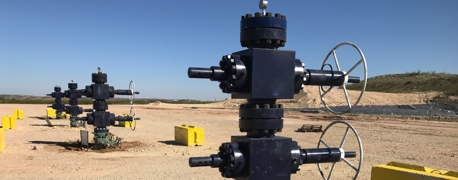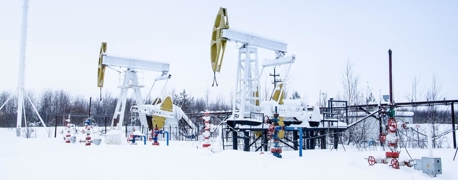Everything You Never Knew About Crude Oil

When you think about crude oil, any of several images may come to mind. You may think of black sludge pouring out of a pipe, an oily sheen marring the ocean’s surface, or perhaps several derricks standing in a Texas field. No matter who you are or where you live, you probably rely on crude oil in more ways than you could possibly imagine. This substance has been the world’s leading energy source for the past 70 years, and that status is likely to continue for decades to come.
But what is crude oil, how do we get it, and what risks does it pose to our health? We’re set to answer the most common (and not so common) questions about crude oil in the United States and worldwide.
What Is Crude Oil & What Does It Look Like?
To understand what crude oil is, we need to know how it was created. A long time ago, marine organisms like algae and plants thrived in shallow seas across the planet. When they died and sunk to the seafloor, they mixed with other matter at the bottom and were buried. Over the course of millions of years, a combination of high pressure and heat transformed these organisms into what we now call fossil fuels. Coal, natural gas, and petroleum are all types of fossil fuels.
Crude oil is unrefined (unprocessed) liquid petroleum. It can be found accumulated within rock formations in the earth’s crust. Although most people think of crude oil as a black, tar-like substance, it actually comes in a variety of colors and consistencies. Depending on its chemical composition, crude oil may be black, dark brown, or tan, or it may have a red, yellow, or green tint to it. Crude oil even has different smells. “Sweet” crude oils smell like gasoline. “Sour” crude oils smell like rotten eggs because they have high levels of sulfur.
Why Is It Called “Crude” Oil?
This substance is called crude oil because it is in its natural or raw state. Crude oil is petroleum that has not been processed or refined in any way.
Where Is Crude Oil Found?
Crude oil can be extracted from petroleum deposits beneath the land or the ocean floor all over the world. Petroleum has collected in vast underground reservoirs that humans access using massive drilling machines on land or out in the ocean. It’s difficult to estimate just how much crude oil is out there, and how much is extractable based on the technology and equipment we currently have. Some petroleum deposits are too difficult to reach based on their location or depth. Others are not pursued because the cost of extraction would outweigh the value of crude oil recovered.
How Much Crude Oil Is Left on Earth?
It’s hard to find a definitive answer to just how much oil is left in the world. In 2019, BP released its Statistical Review of World Energy, which showed there were 1.72 trillion barrels of proven oil reserves left on the planet. To clarify, these proven oil reserves are those that are known about and are extractable based on their location and the cost of extraction versus oil output.
Most estimates are that we have about 47 to 50 years of crude oil left on the planet, but this could change depending on oil demand, focuses on clean energy, and a host of other factors.
Who First Discovered Crude Oil?
Some of the earliest civilizations relied on oil. The first recorded uses of oil can be traced back to the Babylonians, who used oil as mortar to construct buildings and waterproof their boats. Egyptians used oil to mummify corpses. This crude oil was not extracted from deep in the earth, however. It had bubbled to the surface, where it was collected and used by these ancient peoples.
The modern oil industry began in the mid-19th century here in the United States. At a time when kerosene and other products were being created from oil, the first commercial oil well was drilled in Titusville, Pennsylvania in 1859. The well utilized a new technique to dig deeper in the ground, making more deposits accessible and spurring an oil rush that would change the course of history.
Where/How Is Crude Oil Used?
Crude oil is unique in that it is a fuel as well as a base (feedstock) for other products. After refining, crude oil can be used to fuel cars, planes, vessels, generators, and heaters. It can also be used to create products like asphalt, tar, wax, solvents, and lubricating oils. Crude oil is the base for plastic, so virtually every plastic product is made with crude oil. Crude oil is used to create hundreds of products, including some that we might not associate with it. This includes fertilizer, acrylic yarn, lotion, aspirin, crayons, perfume, and computers. The list of crude oil-containing products is quite extensive!
How Much Crude Oil Does the U.S. Produce & Use in a Year?
The United States is the world’s top producer and consumer of crude oil. In 2021, the U.S. consumed an average of 19.78 million barrels of petroleum every day. That same year, the U.S. produced about 18.88 million barrels of crude oil every day, amounting to 20% of the world’s crude oil production.
Can Crude Oil Be Used Right Out of the Ground?
While in ancient times crude oil may have been used without extensive refining processes, that is not the case today. Crude oil is not used in its natural, unrefined state. In fact, there are so many variations of crude oil that there is no universal engine or machine that can run on unrefined crude oil. Depending on how it is to be used, crude oil is put through a specific process, called refining, to be used as fuel or made into various products.
What’s the Difference Between Crude Oil & Other Oils (Motor, Mineral, Organic, Cooking)?
Crude oil is unrefined petroleum that comes from natural deposits in the earth. Other types of oil, like motor oil or the gasoline we put in our cars and trucks, are made from refined crude oil along with other substances. Although cooking oil and crude oil both occur naturally, they have very different uses and properties. Cooking oils, like vegetable oil, avocado oil, olive oil, or coconut oil, are made from food-grade ingredients. Crude oil should never be directly ingested, as it contains a host of toxic substances that can cause serious harm to humans and animals.
How Do Oil Companies Decide Where to Dig for Crude Oil?
Oil companies rely on geologists to locate oil traps, areas where petroleum has gathered underground. Early on, geologists primarily analyzed terrain and surface rock and soil samples to determine whether oil may be present. Today’s oil geologists still analyze terrain and samples but have additional resources like satellite images and high-tech tools such as gravity meters (which measure minute changes in the Earth’s gravitational field), magnetometers (which measure minute changes in the Earth’s magnetic field), and even highly sensitive electronic noses called sniffers that can “sniff out” hydrocarbons. The most common method of finding oil is using seismology, creating shock waves that pass beneath the soil and then interpreting the patterns in the waves as they come back to the surface. This can be done on land or offshore.
How Do Drilling Companies Get Crude Oil Out of the Ground?
There are different methods used to extract crude oil, depending on the geology and location. Vertical drilling and pumping may be effective for lighter, conventional oil that has been trapped in non-porous rock formations. This oil can flow through a well and a pipeline to the surface, where it can then be processed. Unconventional oil, also called light tight oil, cannot be easily extracted. It is often found deep beneath the surface of the earth in rock formations that require horizontal drilling and hydraulic fracturing to remove. Vertical drilling, horizontal drilling, and hydrofracking can be done on land or offshore.
Is Crude Oil Dangerous?
Crude oil is dangerous for several reasons. If it is released into the environment, whether due to an offshore oil spill or a well blowout on land, it can endanger all living things in the area. It can jeopardize delicate marine ecosystems and can kill birds, fish, and other wildlife. It can contaminate groundwater, affecting cattle, crops, and entire communities. Crude oil also poses health risks to any humans who inhale, touch, or ingest it. Benzene, one of the key ingredients of crude oil, is a known carcinogen.
What Are the Health Risks of Short- & Long-Term Crude Oil Exposure?
Short-term exposure to high levels of crude oil can cause skin, eye, nose, and throat irritation. It can burn the skin or can cause headaches, dizziness, nausea, and difficulty breathing if inhaled or ingested.
Long-term crude oil exposure has been linked to birth defects, cancer, infertility, blood disorders, lung damage, hormone imbalances, kidney damage, gene mutations, liver damage, and immune system disorders. This type of exposure is most often associated with one’s occupation or environmental contamination that has impacted groundwater, air, or food sources.
Why Is Crude Oil So Dangerous for Workers?
Working with or around crude oil can be dangerous for many reasons. Oil and gas workers engage in complicated and potentially hazardous operations using heavy machinery and volatile, toxic substances. Crude oil is one of these. They may be at risk of suffering the health effects of acute or chronic exposure, and they may suffer harm in the event of a blowout, fire, explosion, or other catastrophe. Oilfield workers, offshore crew members, tanker truck drivers, and all workers in the oil and gas industry may face the hazards associated with crude oil.
Where Might I Come in Contact with Crude Oil? Should I Worry About Exposure?
Unless you work with oil or its byproducts, live near a plant or refinery, or have an abandoned oil well on your property, direct contact with crude oil is unlikely. Although crude oil is used to produce countless goods, using these products is unlikely to cause exposure. Environmental contamination, oil spills, and occupational exposure are the most common sources of crude oil contact.
Do My Family or My Pets Risk Exposure by Swimming in Lakes, Ponds, or Streams?
The risk of crude oil exposure in a lake, pond, stream, or other body of water is low unless that body of water has been the location of a spill or has been contaminated by an oil extraction or processing operation. If you notice what you believe might be an oil spill or any environmental violation, you can report it to the Environmental Protection Agency (EPA) by calling 1-800-424-8802. If your property or your health have been affected, you can also talk to an attorney about your legal options.
Does Drinking Water from the Tap Increase Your Risk of Crude Oil Exposure?
Drinking water from the tap should not increase your risk of crude oil exposure – unless that water has been contaminated. Even small amounts of oil can pollute a water supply well, so take caution if you use water from a well or water supply that’s located near an oilfield, plant, refinery, or any potential source of crude oil exposure. Drinking oil-contaminated water can cause symptoms like upset stomach, cramping, nausea, throat and mouth irritation, vomiting, and diarrhea. Test your water supply if you suspect a problem and report any contamination to the EPA or appropriate local authority.
Additional Information & Resources
- Categories


